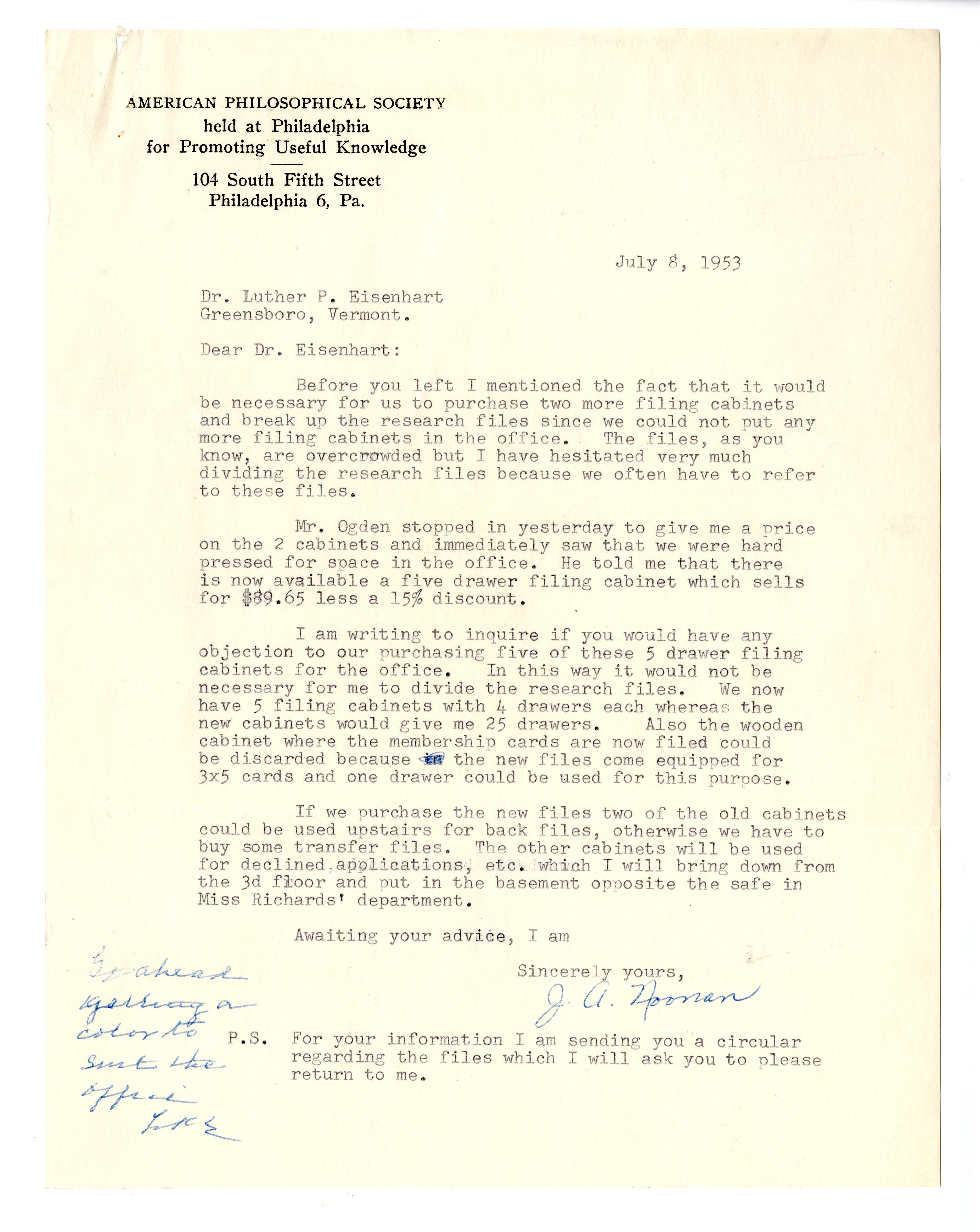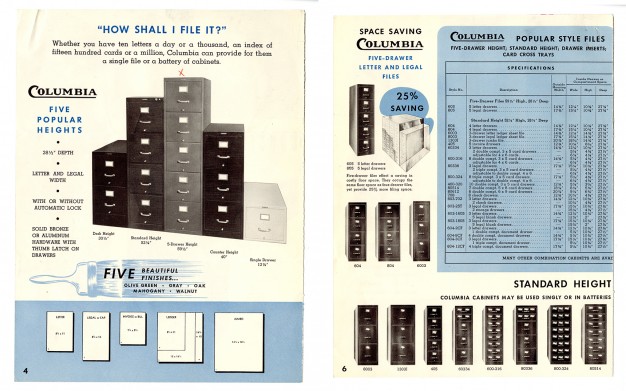How Shall I File It? Records Management, Then & Now
As an archivist, I’ve worked with a variety of institutional archives, ranging from a hospital, to a museum, and now the American Philosophical Society (APS). Regardless of the context, I always find myself drawn into the stories behind the material I process. I suppose it’s part of being human and trying to relate disparate parts to a larger whole. It also feels like cultural tourism, since looking through old files always seems like time travel to me. So when I came across a piece of ephemera dating from the 1950s, I was delighted to be whisked back to the Mad Men era and think about how record-keeping has evolved over the past 70 years (see above).
This promotional flyer for Columbia filing cabinets was found among the records of Dr. Luther P. Eisenhart, a former Executive Officer of the APS. As one can imagine, our “hardware” orders have changed quite a bit between 1953 and 2021! The advertisement was acquired by one of the APS’s secretaries, Julia A. Noonan, who was interested in ordering five 5-drawer cabinets on July 8, 1953. Noonan managed Dr. Eisenhart’s research files, which were actively used and accessible in his office, as well as his “back files” (or less active material) located upstairs in Philosophical Hall. See below for the letter that accompanied the brochure, where Noonan makes her case for additional storage.

It may be hard to remember an era where all records were kept in hard copy, with physical storage at a premium, but it was the reality for most institutions until the late 20th century. While certain computational devices were invented in the 19th century (the Jacquard loom was one of the first in 1804), and main-frame computers like ENIAC developed in the 1940s, computing technology and digital storage weren’t available to most employees until personal computers became popular in the 1980s, with email introduced in the 1990s.
Back to the intrepid Julia Noonan: as a secretary in the 1950s, her job duties entailed dictation, typing, organizing, and filing copious amounts of paper records (which I am now processing!). The categories include correspondence, memoranda, meeting minutes, reports, invitations, legal documents, inventories, manuscript drafts, and index cards, among many others. In turn, these types of documents helped staff to commit an organization’s collective memory to a fixed medium, which is the universal definition for the term “record” (regardless of format).

Given the broad range of records produced by mid-century employees, it’s not surprising that the Columbia cabinet company manufactured a number of drawer shapes and sizes (see above). In addition to Dr. Eisenhart’s research files, other cabinets may have been ordered by APS to store collection materials, like glass plate slides or artifacts. In addition to these items, finding aids —also known as manuscript registers or descriptive inventories—and other helpful guides may have been stored in such cabinets, as well.
Of course, things have changed over time. Speaking as a part-time records manager, I’ve observed how the APS is following a hybrid model, with some paper files still located in most offices, and an increasing number of digital files being maintained on the local network and in cloud storage. As with many institutions, the bulk of our documentation is produced digitally, with “official” records still being printed out, like deeds of gift, contracts, agreements, etc. Convenience copies are also printed, such as paging slips, manuscript proofs, receipts, and other items that serve a temporary purpose, with a “master” copy held in digital form. Since most of our incoming archival collections are in a hybrid form, we will need to think of meaningful ways to connect related material across formats, in order to tell a fuller story.
Even with hybridization and inevitable change brought on by technology, I still get nostalgic when I see these time-tested cabinets around APS. While we now transfer records with enduring value into acid-free boxes, filing cabinets are still used to retain material in offices and storage areas on a temporary to semi-permanent basis. They were built to last back in the day, and their craftsmanship is consistent with the illustrations shown in the brochure (see "Construction," above).
While writing this blog, my curiosity got the better of me: do we still have any of the Columbia filing cabinets ordered by Julia Noonan? I investigated Library Hall and was thrilled to find one five-drawer cabinet in the Manuscripts Processing department, which is pictured below with my colleague Melanie Rinehart. It currently contains inactive records from our Membership Department.

The Columbia logo is still proudly affixed to the front of the cabinet, a solid design on a sturdy product. As a bit of an epilogue, I’m pleased to report that the company is still in business and proud of their 125 year old history. As an archivist, I can’t help but think it’s due to them preserving their records—and ultimately their institutional memory—just as the Society has done over its distinguished lifetime.


